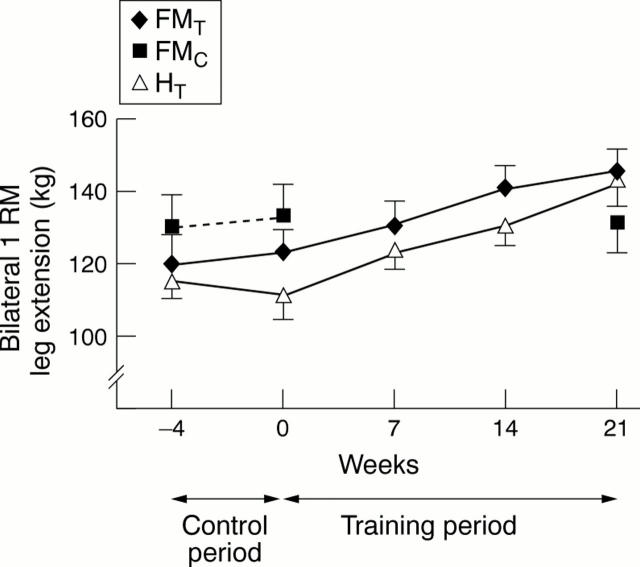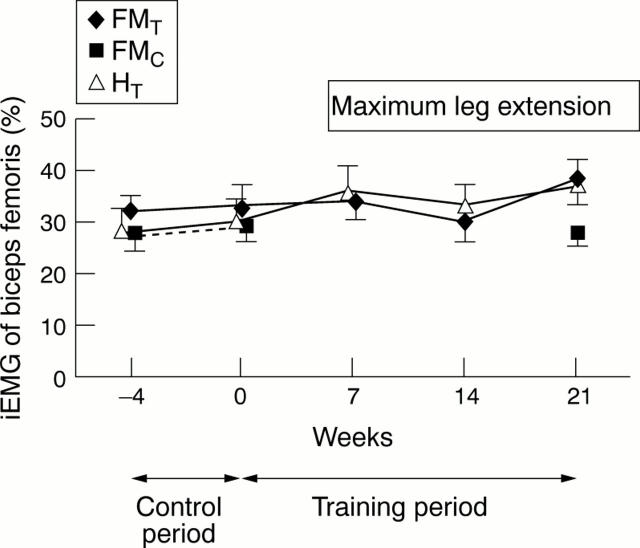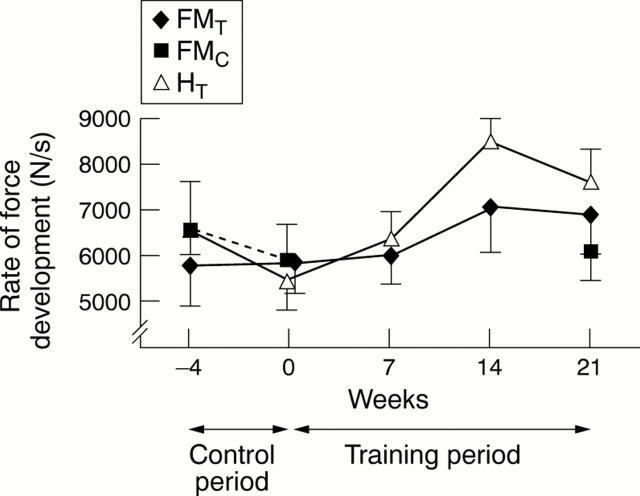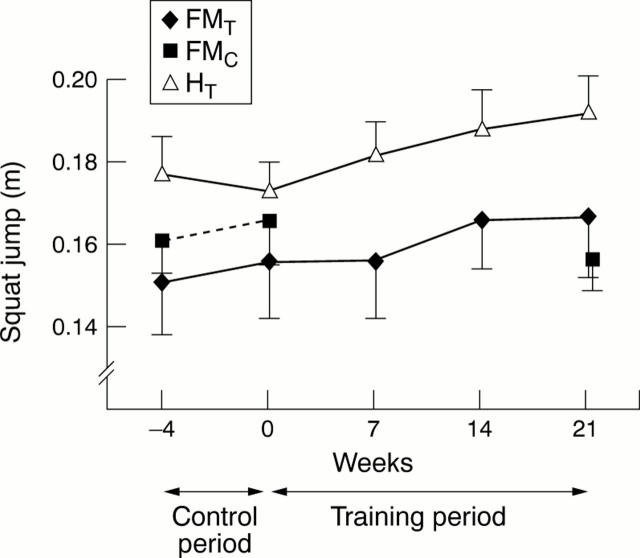Abstract
OBJECTIVE—To investigate the effects of 21 weeks' progressive strength training on neuromuscular function and subjectively perceived symptoms in premenopausal women with fibromyalgia (FM). METHODS—Twenty one women with FM were randomly assigned to experimental (FMT) or control (FMC) groups. Twelve healthy women served as training controls (HT). The FMT and HT groups carried out progressive strength training twice a week for 21 weeks. The major outcome measures were muscle strength and electromyographic (EMG) recordings. Secondary outcome measures were pain, sleep, fatigue, physical function capacity (Stanford Health Assessment Questionnaire), and mood (short version of Beck's depression index). RESULTS—Female FMT subjects increased their maximal and explosive strength and EMG activity to the same extent as the HT group. Moreover, the progressive strength training showed immediate benefits on subjectively perceived fatigue, depression, and neck pain of training patients with FM. CONCLUSIONS—The strength training data indicate comparable trainability of the neuromuscular system of women with FM and healthy women. Progressive strength training can safely be used in the treatment of FM to decrease the impact of the syndrome on the neuromuscular system, perceived symptoms, and functional capacity. These results confirm the opinion that FM syndrome has a central rather than a peripheral or muscular basis.
Full Text
The Full Text of this article is available as a PDF (130.8 KB).
Figure 1 .
Mean (SD) bilateral leg extension (1 RM) in fibromyalgia (FMT) and healthy (HT) trainers and fibromyalgia controls (FMC) during the four week control and 21 week strength training periods.
Figure 2 .
Mean (SD) bilateral isometric leg extension forces in fibromyalgia (FMT) and healthy (HT) trainers and fibromyalgia controls (FMC) during the four week control and 21 week strength training periods.
Figure 3 .
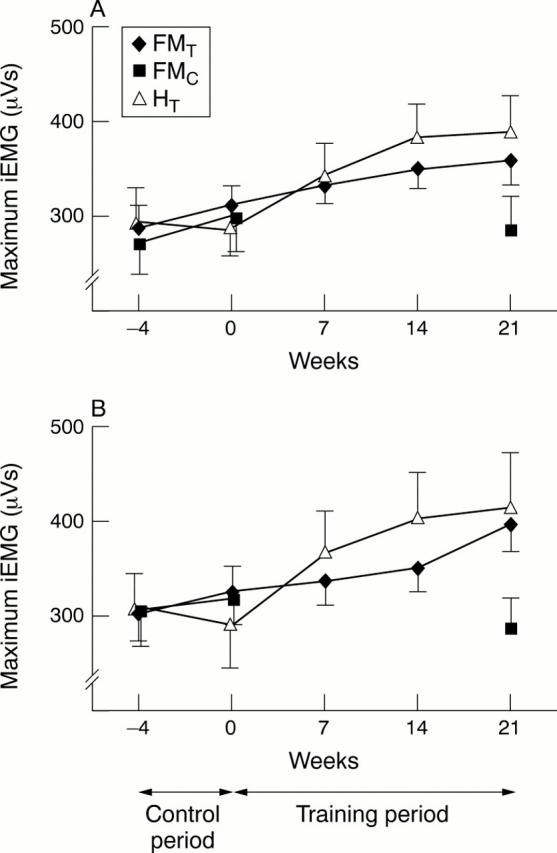
Mean (SD) maximal integrated electromyographic (iEMG) activity of the vastus medialis and vastus lateralis muscles in maximal isometric leg extension in fibromyalgia (FMT) and healthy (HT) trainers and fibromyalgia controls (FMC) during the four week control and 21 week strength training periods. (A) left leg; (B) right leg.
Figure 4 .
Coactivation percentage of the biceps femoris muscle during maximal isometric leg extension in fibromyalgia (FMT) and healthy (HT) trainers and fibromyalgia controls (FMC) during the four week control and 21 week strength training periods.
Figure 5 .
Mean (SD) maximal rate of force development in bilateral isometric leg extension in fibromyalgia (FMT) and healthy (HT) trainers and fibromyalgia controls (FMC) during the four week control and 21 week strength training periods.
Figure 6 .
Mean heights (SD) in maximal vertical squat jump among fibromyalgia (FMT) and healthy (HT) trainers and fibromyalgia controls (FMC) during the four week control and 21 week strength training periods.
Selected References
These references are in PubMed. This may not be the complete list of references from this article.
- BECK A. T., WARD C. H., MENDELSON M., MOCK J., ERBAUGH J. An inventory for measuring depression. Arch Gen Psychiatry. 1961 Jun;4:561–571. doi: 10.1001/archpsyc.1961.01710120031004. [DOI] [PubMed] [Google Scholar]
- Bartels E. M., Danneskiold-Samsøe B. Histological abnormalities in muscle from patients with certain types of fibrositis. Lancet. 1986 Apr 5;1(8484):755–757. doi: 10.1016/s0140-6736(86)91779-4. [DOI] [PubMed] [Google Scholar]
- Baumstark K. E., Buckelew S. P., Sher K. J., Beck N., Buescher K. L., Hewett J., Crews T. M. Pain behavior predictors among fibromyalgia patients. Pain. 1993 Dec;55(3):339–346. doi: 10.1016/0304-3959(93)90009-E. [DOI] [PubMed] [Google Scholar]
- Bengtsson A., Henriksson K. G., Larsson J. Reduced high-energy phosphate levels in the painful muscles of patients with primary fibromyalgia. Arthritis Rheum. 1986 Jul;29(7):817–821. doi: 10.1002/art.1780290701. [DOI] [PubMed] [Google Scholar]
- Bennett R. M., Burckhardt C. S., Clark S. R., O'Reilly C. A., Wiens A. N., Campbell S. M. Group treatment of fibromyalgia: a 6 month outpatient program. J Rheumatol. 1996 Mar;23(3):521–528. [PubMed] [Google Scholar]
- Buckelew S. P., Conway R., Parker J., Deuser W. E., Read J., Witty T. E., Hewett J. E., Minor M., Johnson J. C., Van Male L. Biofeedback/relaxation training and exercise interventions for fibromyalgia: a prospective trial. Arthritis Care Res. 1998 Jun;11(3):196–209. doi: 10.1002/art.1790110307. [DOI] [PubMed] [Google Scholar]
- Carette S., McCain G. A., Bell D. A., Fam A. G. Evaluation of amitriptyline in primary fibrositis. A double-blind, placebo-controlled study. Arthritis Rheum. 1986 May;29(5):655–659. doi: 10.1002/art.1780290510. [DOI] [PubMed] [Google Scholar]
- Clark S., Tindall E., Bennett R. M. A double blind crossover trial of prednisone versus placebo in the treatment of fibrositis. J Rheumatol. 1985 Oct;12(5):980–983. [PubMed] [Google Scholar]
- Doherty M., Jones A. ABC of rheumatology. Fibromyalgia syndrome. BMJ. 1995 Feb 11;310(6976):386–389. doi: 10.1136/bmj.310.6976.386. [DOI] [PMC free article] [PubMed] [Google Scholar]
- Drewes A. M., Andreasen A., Jennum P., Nielsen K. D. Zopiclone in the treatment of sleep abnormalities in fibromyalgia. Scand J Rheumatol. 1991;20(4):288–293. doi: 10.3109/03009749109096802. [DOI] [PubMed] [Google Scholar]
- Ferraccioli G., Ghirelli L., Scita F., Nolli M., Mozzani M., Fontana S., Scorsonelli M., Tridenti A., De Risio C. EMG-biofeedback training in fibromyalgia syndrome. J Rheumatol. 1987 Aug;14(4):820–825. [PubMed] [Google Scholar]
- Fries J. F., Spitz P., Kraines R. G., Holman H. R. Measurement of patient outcome in arthritis. Arthritis Rheum. 1980 Feb;23(2):137–145. doi: 10.1002/art.1780230202. [DOI] [PubMed] [Google Scholar]
- Hannonen P., Malminiemi K., Yli-Kerttula U., Isomeri R., Roponen P. A randomized, double-blind, placebo-controlled study of moclobemide and amitriptyline in the treatment of fibromyalgia in females without psychiatric disorder. Br J Rheumatol. 1998 Dec;37(12):1279–1286. doi: 10.1093/rheumatology/37.12.1279. [DOI] [PubMed] [Google Scholar]
- Hawley D. J., Wolfe F., Cathey M. A. Pain, functional disability, and psychological status: a 12-month study of severity in fibromyalgia. J Rheumatol. 1988 Oct;15(10):1551–1556. [PubMed] [Google Scholar]
- Häkkinen K., Alén M., Komi P. V. Changes in isometric force- and relaxation-time, electromyographic and muscle fibre characteristics of human skeletal muscle during strength training and detraining. Acta Physiol Scand. 1985 Dec;125(4):573–585. doi: 10.1111/j.1748-1716.1985.tb07760.x. [DOI] [PubMed] [Google Scholar]
- Häkkinen K., Kallinen M., Izquierdo M., Jokelainen K., Lassila H., Mälkiä E., Kraemer W. J., Newton R. U., Alen M. Changes in agonist-antagonist EMG, muscle CSA, and force during strength training in middle-aged and older people. J Appl Physiol (1985) 1998 Apr;84(4):1341–1349. doi: 10.1152/jappl.1998.84.4.1341. [DOI] [PubMed] [Google Scholar]
- Häkkinen K., Komi P. V. Electromyographic changes during strength training and detraining. Med Sci Sports Exerc. 1983;15(6):455–460. [PubMed] [Google Scholar]
- Jacobs J. W., Rasker J. J., van der Heide A., Boersma J. W., de Blécourt A. C., Griep E. N., van Rijswijk M. H., Bijlsma J. W. Lack of correlation between the mean tender point score and self-reported pain in fibromyalgia. Arthritis Care Res. 1996 Apr;9(2):105–111. doi: 10.1002/1529-0131(199604)9:2<105::aid-anr1790090206>3.0.co;2-#. [DOI] [PubMed] [Google Scholar]
- Jaeschke R., Adachi J., Guyatt G., Keller J., Wong B. Clinical usefulness of amitriptyline in fibromyalgia: the results of 23 N-of-1 randomized controlled trials. J Rheumatol. 1991 Mar;18(3):447–451. [PubMed] [Google Scholar]
- Martin L., Nutting A., MacIntosh B. R., Edworthy S. M., Butterwick D., Cook J. An exercise program in the treatment of fibromyalgia. J Rheumatol. 1996 Jun;23(6):1050–1053. [PubMed] [Google Scholar]
- McCain G. A., Bell D. A., Mai F. M., Halliday P. D. A controlled study of the effects of a supervised cardiovascular fitness training program on the manifestations of primary fibromyalgia. Arthritis Rheum. 1988 Sep;31(9):1135–1141. doi: 10.1002/art.1780310908. [DOI] [PubMed] [Google Scholar]
- Mengshoel A. M., Komnaes H. B., Førre O. The effects of 20 weeks of physical fitness training in female patients with fibromyalgia. Clin Exp Rheumatol. 1992 Jul-Aug;10(4):345–349. [PubMed] [Google Scholar]
- Moldofsky H., Lue F. A., Mously C., Roth-Schechter B., Reynolds W. J. The effect of zolpidem in patients with fibromyalgia: a dose ranging, double blind, placebo controlled, modified crossover study. J Rheumatol. 1996 Mar;23(3):529–533. [PubMed] [Google Scholar]
- Moritani T., deVries H. A. Neural factors versus hypertrophy in the time course of muscle strength gain. Am J Phys Med. 1979 Jun;58(3):115–130. [PubMed] [Google Scholar]
- Nielson W. R., Walker C., McCain G. A. Cognitive behavioral treatment of fibromyalgia syndrome: preliminary findings. J Rheumatol. 1992 Jan;19(1):98–103. [PubMed] [Google Scholar]
- Nørregaard J., Volkmann H., Danneskiold-Samsøe B. A randomized controlled trial of citalopram in the treatment of fibromyalgia. Pain. 1995 Jun;61(3):445–449. doi: 10.1016/0304-3959(94)00218-4. [DOI] [PubMed] [Google Scholar]
- Park J. H., Phothimat P., Oates C. T., Hernanz-Schulman M., Olsen N. J. Use of P-31 magnetic resonance spectroscopy to detect metabolic abnormalities in muscles of patients with fibromyalgia. Arthritis Rheum. 1998 Mar;41(3):406–413. doi: 10.1002/1529-0131(199803)41:3<406::AID-ART5>3.0.CO;2-L. [DOI] [PubMed] [Google Scholar]
- Simms R. W. Fibromyalgia is not a muscle disorder. Am J Med Sci. 1998 Jun;315(6):346–350. doi: 10.1097/00000441-199806000-00002. [DOI] [PubMed] [Google Scholar]
- Simms R. W., Roy S. H., Hrovat M., Anderson J. J., Skrinar G., LePoole S. R., Zerbini C. A., de Luca C., Jolesz F. Lack of association between fibromyalgia syndrome and abnormalities in muscle energy metabolism. Arthritis Rheum. 1994 Jun;37(6):794–800. doi: 10.1002/art.1780370603. [DOI] [PubMed] [Google Scholar]
- Wigers S. H., Stiles T. C., Vogel P. A. Effects of aerobic exercise versus stress management treatment in fibromyalgia. A 4.5 year prospective study. Scand J Rheumatol. 1996;25(2):77–86. doi: 10.3109/03009749609069212. [DOI] [PubMed] [Google Scholar]
- Wolfe F., Cathey M. A., Hawley D. J. A double-blind placebo controlled trial of fluoxetine in fibromyalgia. Scand J Rheumatol. 1994;23(5):255–259. doi: 10.3109/03009749409103725. [DOI] [PubMed] [Google Scholar]
- Wolfe F., Smythe H. A., Yunus M. B., Bennett R. M., Bombardier C., Goldenberg D. L., Tugwell P., Campbell S. M., Abeles M., Clark P. The American College of Rheumatology 1990 Criteria for the Classification of Fibromyalgia. Report of the Multicenter Criteria Committee. Arthritis Rheum. 1990 Feb;33(2):160–172. doi: 10.1002/art.1780330203. [DOI] [PubMed] [Google Scholar]
- de Blécourt A. C., Wolf R. F., van Rijswijk M. H., Kamman R. L., Knipping A. A., Mooyaart E. L. In vivo 31P magnetic resonance spectroscopy (MRS) of tender points in patients with primary fibromyalgia syndrome. Rheumatol Int. 1991;11(2):51–54. doi: 10.1007/BF00291145. [DOI] [PubMed] [Google Scholar]



